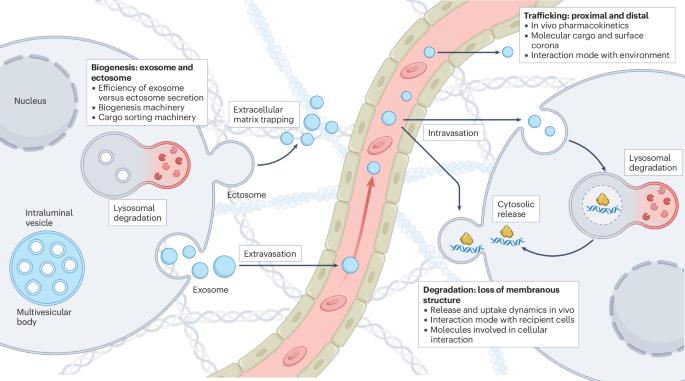Genetic tools for investigating the life cycle of extracellular vesicles
IF 37.6
引用次数: 0
Abstract
Mammalian cells ubiquitously release membrane-enclosed vesicles, known as extracellular vesicles. These particles carry a variety of molecules that reflect the status of their cells of origin, making them valuable sources for biomarker discovery. Furthermore, extracellular vesicles deliver their cargo locally and systemically to regulate biological processes, piquing interest in modulating extracellular vesicle biogenesis and developing extracellular vesicle-based therapies. Therefore, a thorough understanding of the extracellular vesicle life cycle, from biogenesis and trafficking to degradation, is essential for unlocking their full potential in biomarker identification and for the design of extracellular vesicle-based therapies. In this Review, we start by outlining the key steps in the extracellular vesicle life cycle and highlight remaining open questions. We then discuss the design and application of genetically encoded systems that can be applied to study extracellular vesicle biogenesis and fate. Finally, we highlight technical challenges that remain to be addressed in the engineering and application of genetically encoded systems to extracellular vesicle research. A thorough understanding of the life cycle of extracellular vesicles is essential to unleash their full potential in biomarker identification and therapeutics development. This Review discusses the design and application of genetically encoded systems to study extracellular vesicle biogenesis, trafficking and degradation.

研究细胞外囊泡生命周期的遗传工具
哺乳动物细胞普遍释放膜封闭的囊泡,称为细胞外囊泡。这些颗粒携带各种分子,反映其起源细胞的状态,使它们成为发现生物标志物的宝贵来源。此外,细胞外囊泡局部和系统地递送它们的货物来调节生物过程,这激发了人们对调节细胞外囊泡生物发生和开发基于细胞外囊泡的疗法的兴趣。因此,彻底了解细胞外囊泡的生命周期,从生物发生、运输到降解,对于释放它们在生物标志物鉴定和基于细胞外囊泡的治疗设计中的全部潜力至关重要。在这篇综述中,我们首先概述了细胞外囊泡生命周期的关键步骤,并强调了尚未解决的问题。然后我们讨论了基因编码系统的设计和应用,这些系统可以用于研究细胞外囊泡的生物发生和命运。最后,我们强调了在细胞外囊泡研究中基因编码系统的工程和应用中仍有待解决的技术挑战。彻底了解细胞外囊泡的生命周期对于释放其在生物标志物鉴定和治疗开发中的全部潜力至关重要。本文综述了基因编码系统在细胞外囊泡生物发生、运输和降解研究中的设计和应用。
本文章由计算机程序翻译,如有差异,请以英文原文为准。
求助全文
约1分钟内获得全文
求助全文

 求助内容:
求助内容: 应助结果提醒方式:
应助结果提醒方式:


